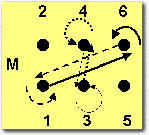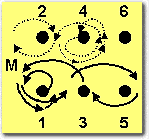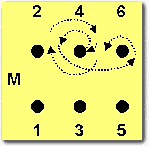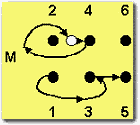Location:
West of Oxford; A40 to Witney and A415 to village turnoff
Brief History of Tradition
The village of Ducklington supported an elaborate Whit-Monday ceremony known as the 'Peeling Horn Ceremony', in which the young men of the village made horns which were used as part of the Whit Hunt in Wychwood Forest. They joined residents from other villages (Hailey, Witney, Leafield and Crawley), who were allowed to hunt, kill and retain a stag during Whitsuntide.
At 3 a.m. on Whit-Monday the young men of the village cut withies from which they removed the bark. This was rolled up into three funnel shaped horns by pinning the bark with thorns (e.g. blackthorn). A double reed of willow was fitted into the narrow end, which enabled the horn to make a loud hooting sound.
The village was roused by this sound at 4 a.m. and all participated in erecting a pre-assembled maypole, which in total measured some 40-ft. The maypole was decorated with 'laycocks and golden chains'. Once assembled the Morris was danced around it; this was thought to be associated with worship of the vegetable world.
The maypole stayed in position all week with the Morris being danced around it every morning and a 'youth ale' held in the evening in a barn. The ale consisted of several barrels of beer, with Morris dancing through the night.
These customs were rigorously adhered to and there is an account of an argument arising from the failure of one side to dance round the maypole on Whit Tuesday before going over to Bampton. A village elder threatened to cut the maypole down if they didn't dance.
Ducklington was stylised by Roy Dommett from the manuscripts of Cecil Sharp and Clive Carey. There are some similarities in style with Bampton, and no stick dances. Ducklington dancers also had a sword and cake ceremony.
It was Joe Marns introduced Ducklington into the Icknield Way Morris Men after attending a tuitional at Wokingham organised by Roy Dommett and Tubby Reynolds. This was in the late 70's and provides a fairly direct link with the Sharp and Carey manuscript interpretations.
Dances Performed by Our Side
Handkerchief Dances |
Stick Dances |
| Boys pf the Bunch (aka Lollipop Man) Jockey to the Fair Green Garters Nutting Girl Trunkles (aka Old Tyle) |
None |
Characteristic Features of Tradition
| Notation |
Glossary of Terms |
GENERAL |
|
| Style | Dancers also have a tendency to end in the 'wrong' positions (top couples and bottom couples having exchanged places). |
| Normal figures | Figures are x2 double-steps + x2 HC. |
| Hand/Arm Movements | Arms are straight up on first beat of bar, and never drop below waist height when dancing. |
| Start | Except for the start of the dance, there is no preparatory movement, i.e. go straight in on first beat of bar.. |
| Finish | All dances finish with x4 Plain Capers (PC) - hands going down up, down up |
STEPS |
|
| Stepping | Double-step with left foot lead |
| Side-Step (sso) - Open | Open with 2 large circular hand movements. At all other times, the hands do not go above shoulder height |
| Plain Capers (PC) | Leaps from one foot to the other taking on appearance of backwards cycling. |
| Upright Capers (UC) | Not to be confused with Fieldtown 'Beetlecrushers'. The sequence is step left, right toe forward, caper right landing left to enable a repeat starting step right, left toe forward, caper left landing right leaving the left foot free for the start of the next movement!!!!! |
| Half Capers (HC) | These are forries as in Bampton and always off the left foot (i.e., left, right, right) |
FIGURES |
|
| Corner Dances | Always turn outwards with x2 HC. Numbers 2 & 5 have been omitted for clarity but their movements are the mirror image of 1 & 6
|
| Side-by-Side (SS) | Dancers advance to form one straight line. Pass right shoulders and return same side. Repeat left shoulders. |
| Back-to-Back (BB) | Dancers advance the minimum amount necessary to pass partners, and move back to form one straight line (not back to place). Return via same track. |
| Hey (H) | The two lines of the set trace out a mirror-image Figure of Eight pattern - Moris Hey. These are accompanied by complicated x2HC turning out. Some examples are given below:
|




